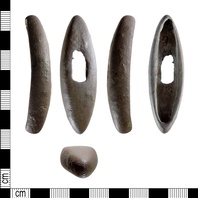
Viking Objects
Sword Hilt or Top Guard (DENO-87124F)
A copper-alloy hilt or top guard from an early medieval, possibly Viking, sword or dagger.
Read More
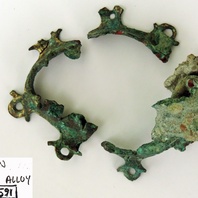
Viking Objects
Gilded Mount (1989-59/7591)
A gilded copper-alloy mount with approximately eight projecting pierced lugs. The mount was found in three pieces and is incomplete. It may originally have been domed, but most of the dome is missing. It has been suggested that it was a shield boss.
Read More

Viking Names
Welby
Welby, in the Framland Hundred of Leicestershire, is a Scandinavian compound from the Old Norse male personal name Āli and the Old Norse element by ‘a farmstead, a village’.
Read More
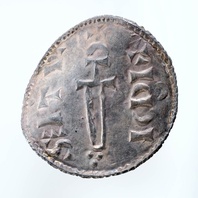
Viking Objects
Sihtric Caoch Silver Penny (CM.863-2002)
A sword and cross type silver penny of Sihtric Caoch (Sihtric Cáech) minted for the Viking kingdom of Northumbria. Sihtric Caoch was the Scandinavian ruler of Dublin from 917-920 CE and subsequently the ruler of Northumbria from 921-927 CE. It is not certain why he left Ireland. The Irish annals state that it was ‘through the grace of God’ and do not elaborate on the politics behind his departure. After the establishment of the Danelaw, some Viking leaders decided to mint their own coins to solidify their legitimacy in the eyes of the local populace. This created a hybrid economy where some members of the Danelaw used bullion and others used coins. This coin was part of a hoard of twelve coins found at Thurcaston between 1992 and 2000. The coins are Anglo-Saxon, Arabic and Viking issues, and show the diverse and wide-ranging contacts between societies at this time. The hoard was probably deposited c.923-925 CE, approximately five years after Leicester had been retaken by Mercia (c.918 CE). They indicate that a bullion economy was still operating in the Danelaw as late as the 920s. This suggests that the reconquest did not manage to institute Anglo-Saxon practices such as a monetary economy immediately.
Read More
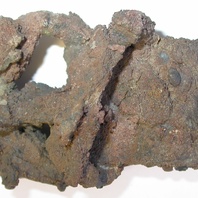
Viking Objects
Iron Buckle (1988/225-9)
An iron buckle found in Mound 6 at Heath Wood, Ingleby, Derbyshire. It is one of two iron buckles found in this burial mound together with a small number of bronze fragments and iron nails. This buckle features a strap slide secured between the backplate and two terminal rivets.
Read More
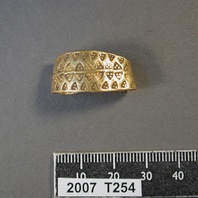
Viking Objects
Gold Stamped Finger Ring (DENO-9A6C17)
A gold finger ring decorated with two rows of interlocking stamped triangles with triple pellets in each. The stamped decoration is typical of Viking jewellery of the late 9th-10th centuries and a punch-decorated gold ring of broadly similar form has been found at Thetford.
Read More
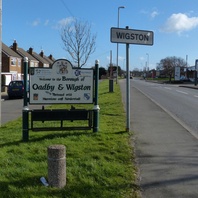
Viking Names
Oadby
Oadby, in the Guthlaxton Hundred of Leicestershire, likely comes from the Old Norse male personal name Auði (Old Danish Øthi) which appears as Owði in the Liber Vitate of Thorney Abbey. A potential alternative for the first element is Old Norse auðr ‘wealth, riches’, which might refer to the easily worked and fertile glacial sand and gravel on which Oadby lies. The second element of the place-name is Old Norse by ‘farm, settlement’. It is now a joint village with Wigston Magna.
Read More
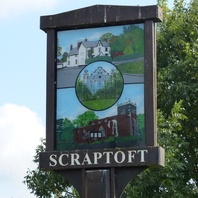
Viking Names
Scraptoft
There are two possibilities for the first element of Scraptoft, in the Gartree Hundred of Leicestershire. The first suggestion is that it is the Old Norse male personal name Skrápi (genitive singular Skrápa). Alternatively, the specific could be the Old Norse element skrap ‘scraps, scrapings’ potentially referring to arid barren soil which may be related to Modern Norwegian skrapmark ‘land thinly covered by grass’. This would be topographically appropriate as the settlement lies on a small area of sand and gravel on top of boulder clay. The second element of the name is Old Norse toft ‘building plot, homestead, curtilage’.
Read More
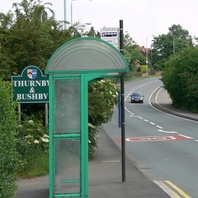
Viking Names
Thurnby
Thurnby, in the Gartree Hundred of Leicestershire, probably derives from Old Norse þyrne, þyrnir, þyrni ‘a thorn-bush’ and Old Norse by ‘a farmstead, a village’. It is also possible that the specific element is the Old Norse byname Þyrnir. However, when taken with the neighbouring parish Bushby these names appear to record an area of former scrubland. This land remained poorly exploited until the period of Scandinavian settlement. Some earlier spellings of the name show substitution of Old English þorn ‘a thorn-tree’ as the first element. Thurnby is now a joint parish with Bushby.
Read More

Viking Names
Ketsby
Ketsby, in the Hill Wapentake of Lincolnshire, comes from the Old Norse male personal name Ketill and the Old Norse element by ‘farmstead, village’. It is a joint parish with South Ormsby.
